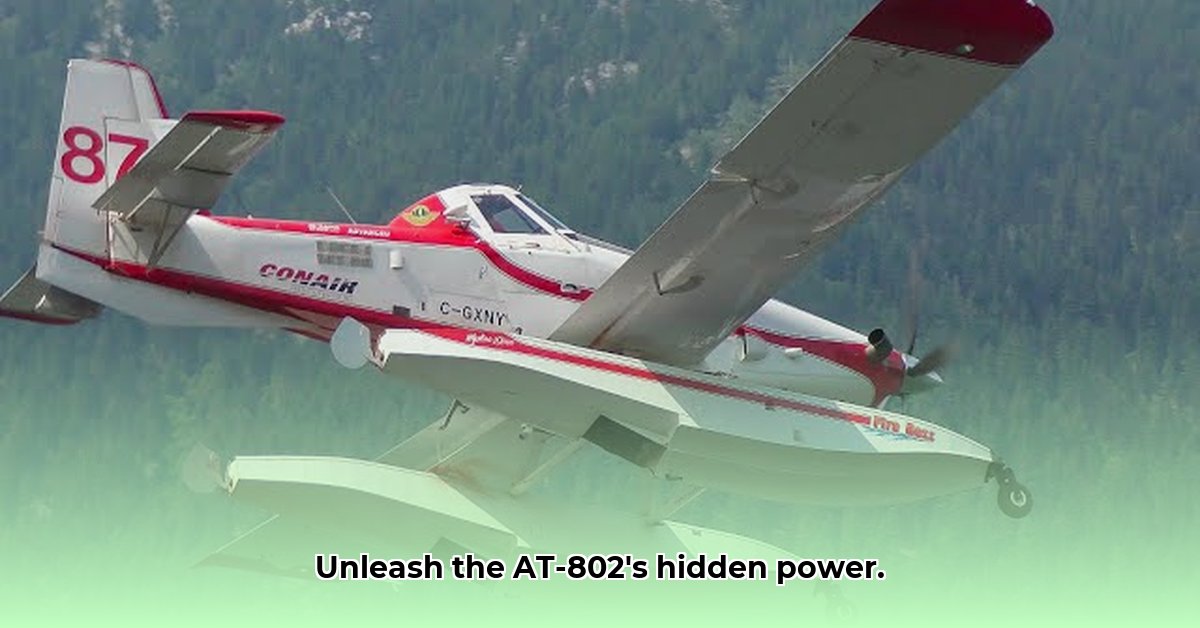
The Air Tractor AT-802 is far more than your average aircraft; it's a versatile workhorse crucial across diverse sectors, from agriculture to military operations. Its adaptability and powerful design have made it a highly sought-after platform, but understanding its capabilities and limitations is key to maximizing its potential. For more detailed specifications, check out the AT-802 specs.
Agricultural Prowess: A High-Capacity Workhorse
The AT-802 excels in agricultural applications, particularly aerial application of fertilizers, pesticides, and seeds. Its substantial payload capacity, including the impressive 800-gallon hopper on the AT-802A model, allows for efficient coverage of vast farmlands, minimizing the number of refilling stops. This translates to significant time and cost savings for agricultural operators. How much time and money can be saved compared to traditional methods? Studies show significant increases in operational efficiency. But what of the environmental impact of these widespread applications? Sustainable strategies are equally critical for responsible agriculture.
Beyond the Fields: Adapting to Diverse Missions
The AT-802's versatility extends beyond agriculture. The Fire Boss configuration, for instance, equips the aircraft with amphibious floats, transforming it into a rapid response tool for firefighting. This capability allows it to quickly and efficiently collect water from various sources, enabling swift action against wildfires. Is this adaptation profitable? Often, specialized contracts offset the costs of conversion.
Military Integration: The OA-1K Sky Warden
The U.S. Special Operations Command's (USSOCOM) $3 billion investment in the OA-1K Sky Warden program underscores the AT-802's military potential. Modified for intelligence, surveillance, and reconnaissance (ISR) missions, as well as close air support, the OA-1K showcases the aircraft's adaptability to complex military operations. "The OA-1K's integration of advanced sensors and weaponry significantly enhances its operational effectiveness in challenging environments," says Dr. Emily Carter, Aerospace Engineering Professor at MIT. This reimagining of the platform highlights its inherent robustness and potential for future military applications. How does the OA-1K's payload capacity compare to other ISR platforms? Detailed comparison studies reveal its competitive advantages.
Navigating the Challenges of Multi-Role Operation
The AT-802's versatility presents logistical and cost management complexities. Maintaining a multi-role fleet requires specialized training, parts procurement, and maintenance expertise across multiple applications. This translates to potentially higher operational costs compared to aircraft dedicated to a single mission profile. "Balancing the benefits of versatility with the added operational complexities requires careful strategic planning," explains Major General Robert Miller, USAF (Ret.), a leading strategist in military logistics. This multifaceted challenge necessitates effective cost controls and streamlined operational procedures.
The Future: Continuous Evolution and Adaptation
The Air Tractor AT-802 continues to evolve with advancements in avionics and sensor technologies. The OA-1K program exemplifies its capacity for significant upgrades, hinting at the potential for future modifications and specialization in areas such as disaster relief or search and rescue operations. What are the most promising avenues for future AT-802 development? Experts suggest focusing on enhanced autonomy and improved data integration.
Strengths and Weaknesses: A Balanced Perspective
The Air Tractor AT-802's success stems from its unique combination of high payload capacity and remarkable adaptability. However, it's crucial to acknowledge the challenges associated with its multi-role nature.
| Feature | Strengths | Weaknesses |
|---|---|---|
| Payload Capacity | Exceptionally high, boosting efficiency and speed. | None significantly reported. |
| Adaptability | Easily modified for diverse missions, from agriculture to military use. | Increased system complexity and potential integration challenges. |
| Operational Costs | Potentially lower initial acquisition costs. | Higher long-term operation and maintenance costs due to operational diversity. |
| Logistical Complexity | Operationally demanding across varied terrains and missions. | Requires specialized training and parts procurement across multiple roles. |
The AT-802's story is one of continuous adaptation and refinement, driven by a need for cost-effective, versatile solutions across various critical sectors.
Minimizing Operational Costs: A Strategic Approach
Operating an AT-802 fleet effectively requires a comprehensive cost management strategy. Simple per-acre cost calculations often overlook critical factors, leading to inaccurate profit assessments. A holistic approach is necessary to ensure long-term financial sustainability.
Key Cost Reduction Strategies
- Preventive Maintenance: Regular maintenance significantly minimizes unexpected repairs and extends aircraft lifespan.
- Fuel Efficiency: Optimize flight routes, pilot training, and consider sustainable aviation fuels (where viable).
- Pilot Training and Retention: Invest in training to enhance safety and efficiency, and implement employee retention programs.
- Effective Fleet Management: Utilize software for cost tracking, maintenance scheduling, and fuel monitoring.
- Negotiate Favorable Deals: Secure competitive prices for fuel, insurance, and parts through strategic partnerships.
- Comprehensive Risk Management: Implement robust safety protocols and secure adequate insurance coverage.
Long-Term Strategies for Profitability
- Explore Financing Options: Consider leasing or financing options to alleviate initial financial burdens.
- Diversify Services: Leverage the AT-802's capabilities to expand into additional service areas (firefighting, seeding, etc.).
- Embrace Technology: Stay updated on technological advancements to improve efficiency and reduce costs.
The Air Tractor AT-802 represents a powerful and adaptable platform, but sustainable success hinges on strategic planning, effective cost management, and a commitment to ongoing technological advancement.